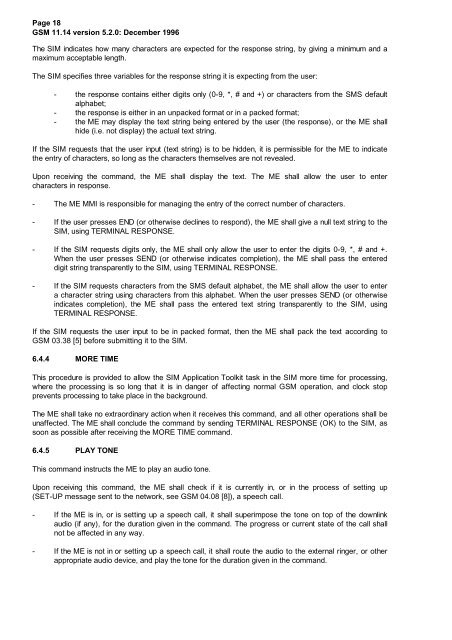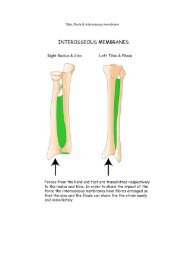GSM 11.14 - Version 5.2.0 - Digital cellular ... - Ttfn.net
GSM 11.14 - Version 5.2.0 - Digital cellular ... - Ttfn.net
GSM 11.14 - Version 5.2.0 - Digital cellular ... - Ttfn.net
Create successful ePaper yourself
Turn your PDF publications into a flip-book with our unique Google optimized e-Paper software.
Page 18<br />
<strong>GSM</strong> <strong>11.14</strong> version <strong>5.2.0</strong>: December 1996<br />
The SIM indicates how many characters are expected for the response string, by giving a minimum and a<br />
maximum acceptable length.<br />
The SIM specifies three variables for the response string it is expecting from the user:<br />
- the response contains either digits only (0-9, *, # and +) or characters from the SMS default<br />
alphabet;<br />
- the response is either in an unpacked format or in a packed format;<br />
- the ME may display the text string being entered by the user (the response), or the ME shall<br />
hide (i.e. not display) the actual text string.<br />
If the SIM requests that the user input (text string) is to be hidden, it is permissible for the ME to indicate<br />
the entry of characters, so long as the characters themselves are not revealed.<br />
Upon receiving the command, the ME shall display the text. The ME shall allow the user to enter<br />
characters in response.<br />
- The ME MMI is responsible for managing the entry of the correct number of characters.<br />
- If the user presses END (or otherwise declines to respond), the ME shall give a null text string to the<br />
SIM, using TERMINAL RESPONSE.<br />
- If the SIM requests digits only, the ME shall only allow the user to enter the digits 0-9, *, # and +.<br />
When the user presses SEND (or otherwise indicates completion), the ME shall pass the entered<br />
digit string transparently to the SIM, using TERMINAL RESPONSE.<br />
- If the SIM requests characters from the SMS default alphabet, the ME shall allow the user to enter<br />
a character string using characters from this alphabet. When the user presses SEND (or otherwise<br />
indicates completion), the ME shall pass the entered text string transparently to the SIM, using<br />
TERMINAL RESPONSE.<br />
If the SIM requests the user input to be in packed format, then the ME shall pack the text according to<br />
<strong>GSM</strong> 03.38 [5] before submitting it to the SIM.<br />
6.4.4 MORE TIME<br />
This procedure is provided to allow the SIM Application Toolkit task in the SIM more time for processing,<br />
where the processing is so long that it is in danger of affecting normal <strong>GSM</strong> operation, and clock stop<br />
prevents processing to take place in the background.<br />
The ME shall take no extraordinary action when it receives this command, and all other operations shall be<br />
unaffected. The ME shall conclude the command by sending TERMINAL RESPONSE (OK) to the SIM, as<br />
soon as possible after receiving the MORE TIME command.<br />
6.4.5 PLAY TONE<br />
This command instructs the ME to play an audio tone.<br />
Upon receiving this command, the ME shall check if it is currently in, or in the process of setting up<br />
(SET-UP message sent to the <strong>net</strong>work, see <strong>GSM</strong> 04.08 [8]), a speech call.<br />
- If the ME is in, or is setting up a speech call, it shall superimpose the tone on top of the downlink<br />
audio (if any), for the duration given in the command. The progress or current state of the call shall<br />
not be affected in any way.<br />
- If the ME is not in or setting up a speech call, it shall route the audio to the external ringer, or other<br />
appropriate audio device, and play the tone for the duration given in the command.








